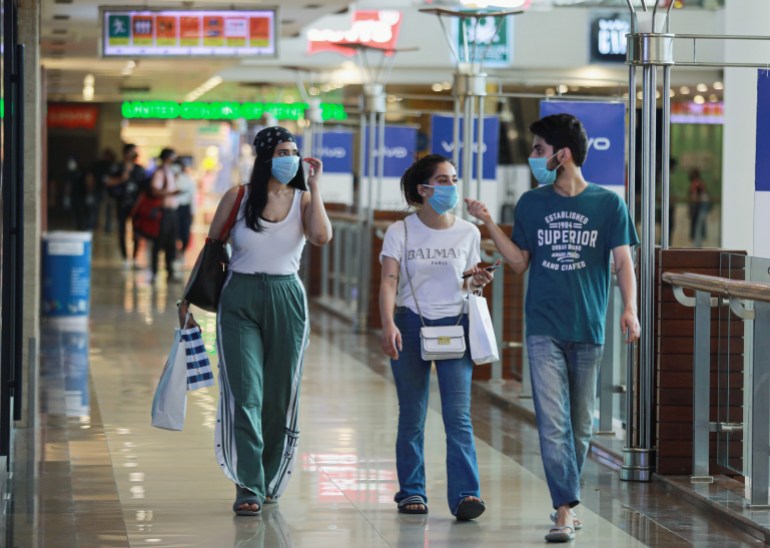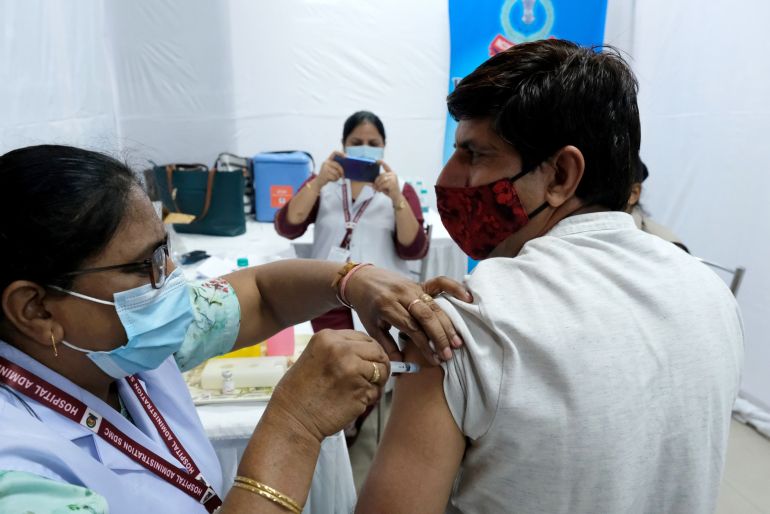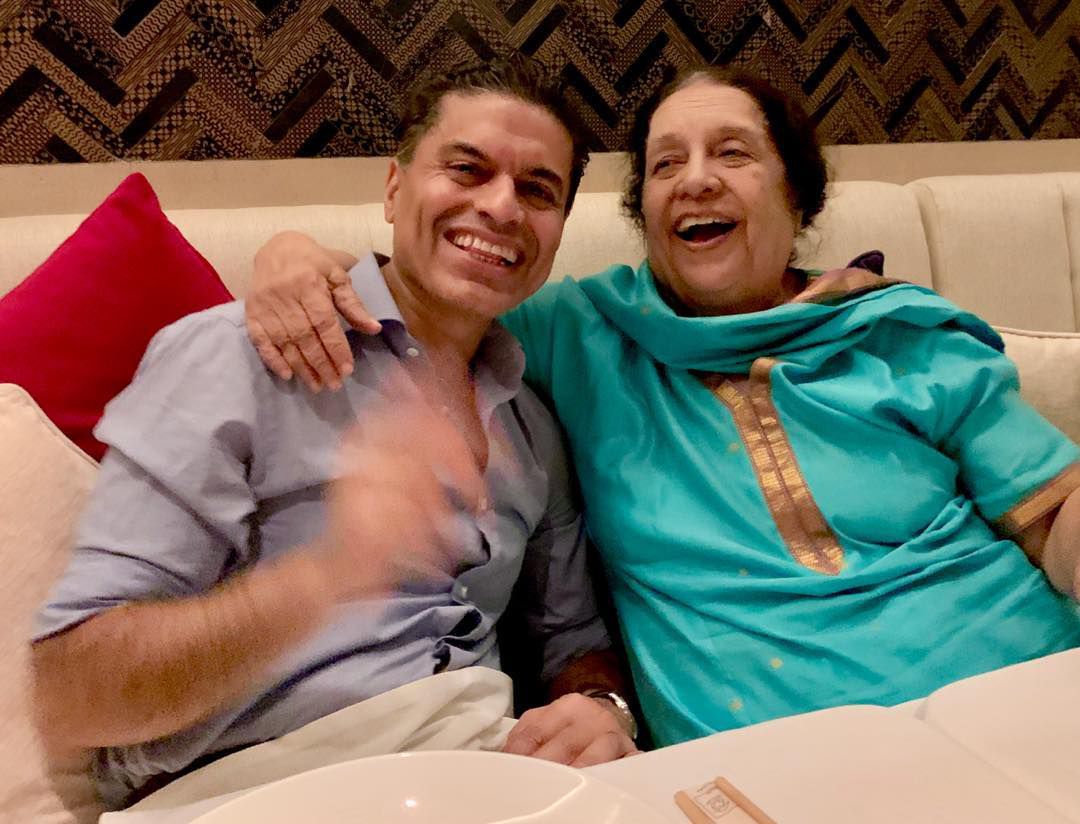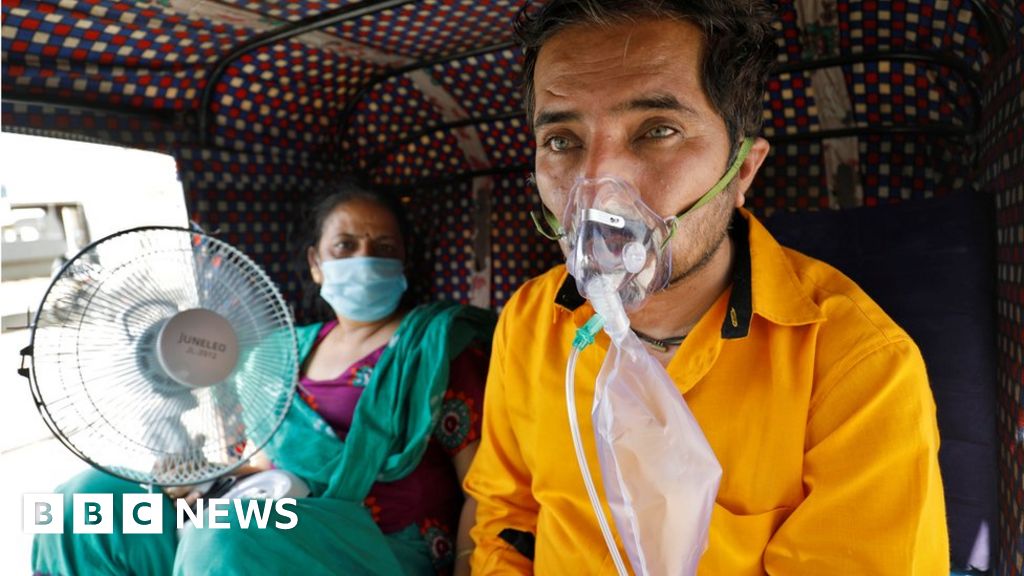Tuliza mshonoCovid: India on UK travel red list as Covid crisis grows
Coronavirus pandemic
A medic tests a bus passenger in Jaipur, Rajasthan, India, on Thursday
India has joined the UK's travel red list - effectively banning travel - as a deadly second wave of infections sweeps the country.
British and Irish nationals can travel to the UK from India, but they must now isolate in a government-approved hotel.
India has seen soaring infection rates, a rapidly rising death toll and the discovery of a new virus variant.
The spike has overwhelmed hospitals, creating a critical shortage of oxygen, intensive care beds and ventilators.
What are the travel quarantine rules?
Why was India not already on the red list?
Why India is running out of oxygen again
On Friday, India recorded 332,730 coronavirus cases, the highest one-day tally anywhere in the world for the second day in a row. Daily deaths from Covid-19 rose by a record 2,263 in the previous 24 hours.
At least two hospitals in the Indian capital Delhi are running out of oxygen, and at least 13 patients have died after a fire broke out in the intensive care unit of a hospital set up to treat Covid patients near Mumbai.
The rising number of cases has resulted in a deepening healthcare crisis that has gripped several states, and India's top court has asked the central government for a national plan by Friday on bolstering supply, oxygen, medicine, treatment and vaccines.
'Ordeal after ordeal'
Nayan Gangyan
Nayan Gangyan is facing a 10-day hotel quarantine when he flies back to London from northern India on Saturday. He travelled to Chandigarh a few weeks ago, when his parents both contracted coronavirus.
He told BBC Breakfast he was left feeling "helpless" in the UK when his father's oxygen levels dropped, there were no beds available in hospital and his mother started to panic.
"It was at that point that I decided 'my family needs help and I need to go back come what may'," he says.
He says the situation in India is "really bad", with the government healthcare system "completely overrun". But they eventually managed to get his father admitted to a hospital where he had previously undergone a liver transplant, and he is doing "much better now".
Now Nayan is preparing to return home to London. "The flight as of now, it's running. I really hope that it does take off," he says.
"I've already booked my quarantine hotel so I'll be going straight there. I'll be landing [then] straight to the hotel and 10 days in the room."
Vani Goyal
His wife Vani, who has been watching from a distance from their London home, says it has been difficult "not to be able to control or influence" events.
On India's red list status, she says: "We got just over three days' notice so very little time for us to actually affect the outcome or do anything.
"We're just in the position where we have to be okay. After Nayan's ordeal in India he has to go through another ordeal."
line
Tina Patel and her husband arrived back in the UK on Thursday from Pune, Maharashtra, after travelling to India in March to visit her father-in-law, who was ill due to old age and later died.
She told the BBC people in the city were "desperate" - trying to find hospital beds or a slot in the crematoriums. "We left a city with ambulances wailing away day and night," she said.
"I left broken-hearted as there was nothing we could do but catch the BA flight last night and all we could do was to be thankful that we finally got home."
Friday's travel rule change means direct flights from India are still permitted, but UK and Irish nationals, as well as those with residency rights, must isolate in government-approved hotels - at their own cost - for 10 days.
Travel to the UK is banned for all others who have been in red-list countries in the past 10 days.
There are 40 countries on the government's red list across the Middle East, Africa, Asia and South America. Countries can be added to the list with just a few hours' notice.
There are specific rules for people arriving in each UK nation, including England, Scotland, Northern Ireland and Wales.
'It feels like we're back to square one in India'
What is the India Covid variant?
Public Health England (PHE) confirmed on Thursday that a further 55 cases of the virus variant first identified in India - known as B.1.617 - were found in the UK in the latest week to 14 April.
PHE experts are currently unsure whether any of the mutations mean the variant can be transmitted more easily, is more deadly or can evade the effectiveness of vaccines or natural immunity.
The final scheduled commercial flight ahead of the rule change - Vistara flight VTI017 - landed at London's Heathrow Airport at 18:48 on Thursday, according to FlightRadar24.
Four airlines asked for a total of eight extra flights to arrive at the west London airport before the 04:00 deadline but were refused permission by airport authorities.
Heathrow bosses are believed to have declined the requests to ensure pressures at the border, reported in recent weeks, were not exacerbated.
Later scheduled arrivals from Delhi and Mumbai to Heathrow, and Delhi to Gatwick Airport, were cancelled on Thursday, airport data showed.
media captionTravellers returning from India: "Oh my goodness, feeling so relieved"
Some of those who arrived before the red list change told the BBC they "couldn't afford to stay away" and "had to get back to work".
"Eventually, yesterday, a friend in the UK managed to book me a ticket from Mumbai to Manchester," Biju Mathew, a social services manager from Walsall, said.
Demand for flights from India to the UK quickly became overwhelming after the government's red list announcement, according to Suresh Kumar, chairman of specialist travel agents Indra Travel.
"A lot of people were hoping that the [UK] government would have made arrangements for people trying to get back," he said. "They were disappointed."
Speaking on Tuesday, Prime Minister Boris Johnson - who cancelled an official visit to India due to take place next Monday - said the addition to the red list was a "purely precautionary" step over a new coronavirus variant.
He said: "What we're seeing in India is a result of a variant under investigation, it hasn't yet been deemed a variant of concern - I think that was why there has been the delay."
Navigation
More options
You are using an out of date browser. It may not display this or other websites correctly.
You should upgrade or use an alternative browser.
You should upgrade or use an alternative browser.
Nchi nyingi duniani zimewazuia wasafiri toka India kuingia kwenye Nchi zao, Tanzania tunasubiri nini?
BAK
JF-Expert Member
- Feb 11, 2007
- 124,789
- 288,015
- Thread starter
- #44
As COVID cases surge in India, what next for the economy?
The IMF says the surge in new COVID cases represents a ‘worrisome downside risk’ to India’s economy, and it’s the poorest who may be worst hit.![India has seen a recent surge in COVID cases, pushing it to the second-highest number of cases globally [File: Danish Siddiqui/Reuters] India has seen a recent surge in COVID cases, pushing it to the second-highest number of cases globally [File: Danish Siddiqui/Reuters]](/proxy.php?image=https%3A%2F%2Fwww.aljazeera.com%2Fwp-content%2Fuploads%2F2021%2F04%2F2021-04-15T115456Z_1214167135_RC2AWM9C4ITJ_RTRMADP_3_HEALTH-CORONAVIRUS-INDIA-HOSPITAL-1.jpg%3Fresize%3D770%252C513&hash=56d1e5e2e4dddefaf40198b0d4d8ed4b)
India has seen a recent surge in COVID cases, pushing it to the second-highest number of cases globally [File: Danish Siddiqui/Reuters]
20 Apr 2021
New Delhi, India – A “tsunami”. That is how a doctor at a government-run hospital in the Indian capital, New Delhi, described to Al Jazeera the latest wave of COVID-19 infections. The medic declined to be named for fear of reprisals.
India’s tally of new COVID-19 cases hit a new record of more than 270,000 on Monday, pushing its total to more than 15 million, the second-highest globally after the United States. And on Tuesday, it reported 1,761 deaths due to the coronavirus, another record. Hospitals are struggling to cater to patients in need of beds, oxygen and medicines, and social media is flooded with cries of help for those services.
KEEP READING
Britain’s Johnson cancels India trip amid record COVID spikeModi slammed on social media amid deadly COVID-19 surge in IndiaNon-stop cremations cast doubt on India’s counting of COVID dead49 passengers on India-Hong Kong flight test positive for COVID
The new surge in cases has not prevented political parties from holding mass rallies as several states go to the polls, even as some states, including New Delhi, announced localised lockdowns and curfews.
All of this is likely to eventually take a toll on the country’s economic recovery, some economists say.
How has the Indian economy held up so far?
Surprisingly well. After shrinking by a record 24.4 percent in the three months through June 2020 – which was “consistent with the stringency of the lockdown” the government imposed at the time, according to Barclays India Economist Rahul Bajoria – economic activity picked up and eked out a growth rate of 0.4 percent for the quarter ending December compared to the same period the year before, latest figures show.
So how is the latest wave of infections going to affect the economy?
Since the recent surge is, well, relatively recent, its effect has yet to be reflected in economic data. From an economic perspective, the main difference between the first COVID-19 outbreak last year and this year’s is that this time around the government is not trying to shut businesses down.But allowing economic activity to continue now could fuel the spread of the virus, which may be bad for the businesses later on.
Is another national lockdown likely?
The second wave has set off fears of another national lockdown. Last year’s lockdown, one of the world’s strictest, was implemented with a mere four hours’ notice, trapping many with little access to basic services. So one cannot really blame the rumour mill for being on overdrive of late.How are people reacting?
Some of the migrant workers who usually leave the cities for their rural villages in the summer to harvest crops are heading back earlier than they typically would in case they get caught unawares once again. It is still too early to say how many are leaving and how their early departure will affect businesses in the cities. And while hardly anyone expects the country to be locked down like last year, it remains anyone’s guess as to how the virus may progress and what actions the federal or state governments may take in response. “Economic loss will build up overtime,” says Barclays’ Bajoria.For now, the International Monetary Fund is forecasting India’s growth rate for 2021 to be 12.5 percent but has warned that “the current surge in infections presents a worrisome downside risk.”
Which sectors are likely to be affected the most if things get worse?
Sectors such as malls, travel and tourism, spas and salons will most likely bear the brunt of the second wave as Indians once again hunker down at home to avoid getting infected. For instance, the country’s civil aviation minister tweeted that on 17 April about 182,000 boarded domestic flights. That was down from around 313,000 in late February, the highest since these flights resumed last May.Some of this is bound to spill over into the so-called informal sector as well. Street vendors operating food and drink stalls or neighbourhood kiosks that sell items such as loose cigarettes and snacks could be among the first to lose out if cases continue to rise.
Why does that matter?
The vast majority – 90.7 percent (PDF) – of India’s workers operate in the informal sector, without written contracts, paid leave, health benefits or social security, according to the International Monetary Fund’s latest available data. So a prolonged period of uncertainty could affect hundreds of millions of India’s poor and that could again hurt growth.What else is likely to be affected?
Taxes! Aviation, tourism, fuel, and so-called sin goods such as alcohol and cigarettes are some of the most highly-taxed sectors in the country. A dip in government revenues from these would represent money that could otherwise be used to ramp up India’s vaccination rollout or meet any of its myriad other needs.So how does India get the pandemic under control while keeping the economy humming along?

As of April 11, the rate of vaccines being administered was averaging 3.6 million shots a day, with nearly 26 million vaccines administered in the week ending 10 April, according to a Barclays report sent to Al Jazeera, bringing it in line with the US in terms of the pace of vaccinations.
That sounds good. So India’s getting things under control then?
It may be difficult for India to continue at that pace as demand outpaces supply and with several states reporting a shortage of vaccines. With the federal government opening vaccine access to everyone above the age of 18 from May 1, demand is set to shoot up even more.To deal with that shortage in the midst of the ongoing surge, New Delhi has said it will fast-track emergency approvals for COVID-19 vaccines that have been authorised by Western countries and Japan. In other words, it’s eliminating (or at least reducing) bureaucracy to allow imports of Pfizer-BioNTech, Johnson & Johnson, Novavax and Moderna shots and has also approved the use of Russia’s Sputnik V.
There’s hope for India’s people and its economy. But it is going to be a race against time and the emergence of new, possibly more infectious variants of the virus.
SOURCE: AL JAZEERA
The Icebreaker
JF-Expert Member
- Feb 11, 2018
- 18,159
- 51,092
Angalia hiyo clip Mkuu,Maiti zipo kwenye foleni,zinasubiri zamu yao yakuchomwa.Jana nilikuwa ofisi za Emirates wanasema watasitisha safari za India, wale wote wanaosafiri watajitafutia usafiri wa kurudi wenyewe.
Pia wanasema watu wqnakufa India mpaka mbao za kuchomea maiti zimekuwa adimu
Attachments
mjingamimi
JF-Expert Member
- Aug 3, 2015
- 39,286
- 44,843
kaka Corona India NI propaganda.kuna video inaonesha madokta wamewatoa maiti viungo vya ndani na kusema wamekufa na Corona.
Ili wakaviuze.watu wameshtuka.
Maiti zimetolewa,figo,moyo,mapafu, ubongo n.k
Ili wakaviuze.watu wameshtuka.
Maiti zimetolewa,figo,moyo,mapafu, ubongo n.k
Angalia hiyo clip Mkuu,Maiti zipo kwenye foleni,zinasubiri zamu yao yakuchomwa.
BAK
JF-Expert Member
- Feb 11, 2007
- 124,789
- 288,015
- Thread starter
- #48
Kwa hiyo hivyo vifo vya Covid ni uongo? Hebu tuwekee hiyo video usikute hiyo ndiyo uzushi.
kaka Corona India NI propaganda.kuna video inaonesha madokta wamewatoa maiti viungo vya ndani na kusema wamekufa na Corona.
Ili wakaviuze.watu wameshtuka.
Maiti zimetolewa,figo,moyo,mapafu, ubongo n.k
BAK
JF-Expert Member
- Feb 11, 2007
- 124,789
- 288,015
- Thread starter
- #49

CNN's Fareed Zakaria Pays Tribute to His Mom After Losing Her to COVID: 'She Wanted the Best for Us'
Journalist Fareed Zakaria, who hosts Fareed Zakaria GPS on CNN, announced his mother's death on social media April 6
kaka Corona India NI propaganda.kuna video inaonesha madokta wamewatoa maiti viungo vya ndani na kusema wamekufa na Corona.
Ili wakaviuze.watu wameshtuka.
Maiti zimetolewa,figo,moyo,mapafu, ubongo n.k
BAK
JF-Expert Member
- Feb 11, 2007
- 124,789
- 288,015
- Thread starter
- #51

Covid: Countries send aid to ease India's oxygen emergency
The UK is sending oxygen machines and ventilators while France and the US are also sending supplies.
kaka Corona India NI propaganda.kuna video inaonesha madokta wamewatoa maiti viungo vya ndani na kusema wamekufa na Corona.
Ili wakaviuze.watu wameshtuka.
Maiti zimetolewa,figo,moyo,mapafu, ubongo n.k
I am Groot
JF-Expert Member
- Jul 20, 2018
- 3,731
- 10,033
Tutapata akili hali ikianza kuwa mbaya
BAK
JF-Expert Member
- Feb 11, 2007
- 124,789
- 288,015
- Thread starter
- #53
International efforts are under way to help India as the country suffers critical oxygen shortages amid a devastating surge in Covid cases.
The UK has begun sending ventilators and oxygen concentrator devices. EU members are also due to send aid.
The US is lifting a ban on sending raw materials abroad, enabling India to make more of the AstraZeneca vaccine.
India's capital Delhi has extended its lockdown as overcrowded hospitals continue to turn patients away.
The government has approved plans for more than 500 oxygen generation plants across the country to boost supplies.
Meanwhile neighbouring Bangladesh has announced that it will close its border with India from Monday to prevent the spread of the virus.
Patients die without oxygen amid Delhi Covid surge
A city where breathing has become a luxury
Viral picture that defines India's Covid distress
India reported 349,691 more cases in the 24 hours to Sunday morning and another 2,767 deaths, however the true figures are thought to be much higher.
What is the UK sending?
The first consignment of aid left the UK on Sunday and is due to arrive in India on Tuesday. Further shipments will take place later in the week.
The aid includes 495 oxygen concentrators - which can extract oxygen from the air when hospital oxygen systems have run out - as well as 120 non-invasive ventilators and 20 manual ventilators.
"We stand side by side with India as a friend and partner during what is a deeply concerning time in the fight against Covid-19," UK Prime Minister Boris Johnson said in a statement.
The spike in infection has led to the cancellation of a planned visit by Mr Johnson to India and to a travel ban. Other nations, including the UAE, Canada, Germany and the Netherlands have also banned flights from India.
View original tweet on Twitter
1px transparent line
What about the US and others?
The White House says it will immediately provide raw materials for vaccines to Indian vaccine manufacturers.
"Just as India sent assistance to the United States as our hospitals were strained early in the pandemic, we are determined to help India in its time of need," said President Joe Biden.
It follows calls by Indian officials and the Serum Institute of India (SII) for the US to lift export controls on raw materials for vaccines that were put in place in February.
Washington has also been criticised for delaying a decision on sending surplus vaccine doses abroad. The US has millions of unused doses of the AstraZeneca vaccine, which has not yet been approved for use there. Top infectious diseases expert Dr Anthony Fauci said the option of sending them to India was being considered.
The US will also provide medical equipment and protective gear. France meanwhile says it will provide oxygen.
patient on oxygen in rickshaw
image captionA patient in an auto-rickshaw waiting to be allowed into a hospital in the city of Ahmedabad
In Brussels, the European Commission said it planned to send oxygen and medicine too. Its head Ursula von der Leyen said the organisation was "pooling resources to respond rapidly to India's request for assistance".
India's neighbour Pakistan - which has tense relations with Delhi amid territorial disputes - offered medical equipment and supplies and its Prime Minister Imran Khan tweeted prayers for a "speedy recovery". The country's Edhi foundation has also offered to send a fleet of 50 ambulances to India.
SOURCE: BBC World News
The UK has begun sending ventilators and oxygen concentrator devices. EU members are also due to send aid.
The US is lifting a ban on sending raw materials abroad, enabling India to make more of the AstraZeneca vaccine.
India's capital Delhi has extended its lockdown as overcrowded hospitals continue to turn patients away.
The government has approved plans for more than 500 oxygen generation plants across the country to boost supplies.
Meanwhile neighbouring Bangladesh has announced that it will close its border with India from Monday to prevent the spread of the virus.
Patients die without oxygen amid Delhi Covid surge
A city where breathing has become a luxury
Viral picture that defines India's Covid distress
India reported 349,691 more cases in the 24 hours to Sunday morning and another 2,767 deaths, however the true figures are thought to be much higher.
What is the UK sending?
The first consignment of aid left the UK on Sunday and is due to arrive in India on Tuesday. Further shipments will take place later in the week.
The aid includes 495 oxygen concentrators - which can extract oxygen from the air when hospital oxygen systems have run out - as well as 120 non-invasive ventilators and 20 manual ventilators.
"We stand side by side with India as a friend and partner during what is a deeply concerning time in the fight against Covid-19," UK Prime Minister Boris Johnson said in a statement.
The spike in infection has led to the cancellation of a planned visit by Mr Johnson to India and to a travel ban. Other nations, including the UAE, Canada, Germany and the Netherlands have also banned flights from India.
View original tweet on Twitter
1px transparent line
What about the US and others?
The White House says it will immediately provide raw materials for vaccines to Indian vaccine manufacturers.
"Just as India sent assistance to the United States as our hospitals were strained early in the pandemic, we are determined to help India in its time of need," said President Joe Biden.
It follows calls by Indian officials and the Serum Institute of India (SII) for the US to lift export controls on raw materials for vaccines that were put in place in February.
Washington has also been criticised for delaying a decision on sending surplus vaccine doses abroad. The US has millions of unused doses of the AstraZeneca vaccine, which has not yet been approved for use there. Top infectious diseases expert Dr Anthony Fauci said the option of sending them to India was being considered.
The US will also provide medical equipment and protective gear. France meanwhile says it will provide oxygen.
patient on oxygen in rickshaw
image captionA patient in an auto-rickshaw waiting to be allowed into a hospital in the city of Ahmedabad
In Brussels, the European Commission said it planned to send oxygen and medicine too. Its head Ursula von der Leyen said the organisation was "pooling resources to respond rapidly to India's request for assistance".
India's neighbour Pakistan - which has tense relations with Delhi amid territorial disputes - offered medical equipment and supplies and its Prime Minister Imran Khan tweeted prayers for a "speedy recovery". The country's Edhi foundation has also offered to send a fleet of 50 ambulances to India.
SOURCE: BBC World News
Yaani sisi! Korona ni kama vile kimbunga Yobo. Kilipogusa mipaka ya Tanzania tu kikafa! Haya endeleeni kujifariji!Unaishi kwa woga sana kama lisu
Shadow7
JF-Expert Member
- Sep 28, 2020
- 13,796
- 20,205
Kabisa mkuuKabisa Mkuu au huu ugonjwa ambao sasa umetulia sana nchini utalipuka tena na hapo itakuwa ni vilio vya kusaga meno.
mjingamimi
JF-Expert Member
- Aug 3, 2015
- 39,286
- 44,843
Hyo hapo.vyombo vya habari vya kimataifa wanafanya siri
Kwa hiyo hivyo vifo vya Covid ni uongo? Hebu tuwekee hiyo video usikute hiyo ndiyo uzushi.
Clemence Mwandambo
JF-Expert Member
- Dec 2, 2018
- 1,302
- 1,337
Tanzania sio nchi ya copy and paste katika suala la Covid.
Similar Discussions
-
Tunayopendekeza yafanyike Tanzania hayafanyiki alafu Nchi jirani Wanafanya kweli!
- Started by Lord denning
- Replies: 18
-
-
Kati ya nchi 10 zitakazoongoza kwa kasi ya ukuaji wa uchumi duniani mwaka 2024, nchi 6 zinatoka Afrika ikiwemo Tanzania
- Started by ChoiceVariable
- Replies: 23
-
Will Tanzania's New Region Bear the Name of the Ulanga River? Splitting Morogoro Region
- Started by Tabutupu
- Replies: 68
-
Waasi wa M23/AFC walalamika Tanzania kumkamata kiongozi wao aitwae Eric Nkuba na kumkabidhi kwa Serikali ya DRC
- Started by kibarango
- Replies: 89